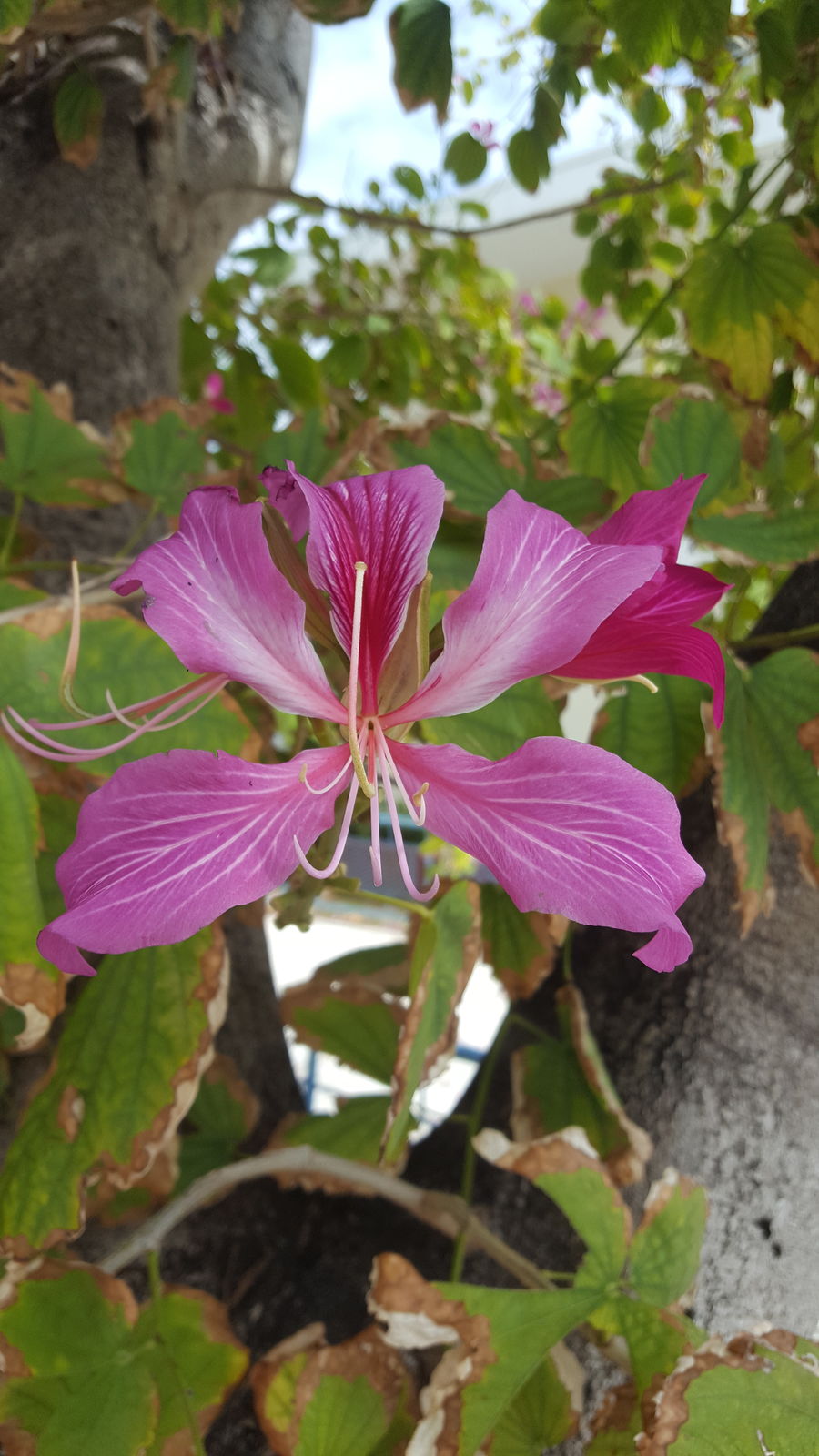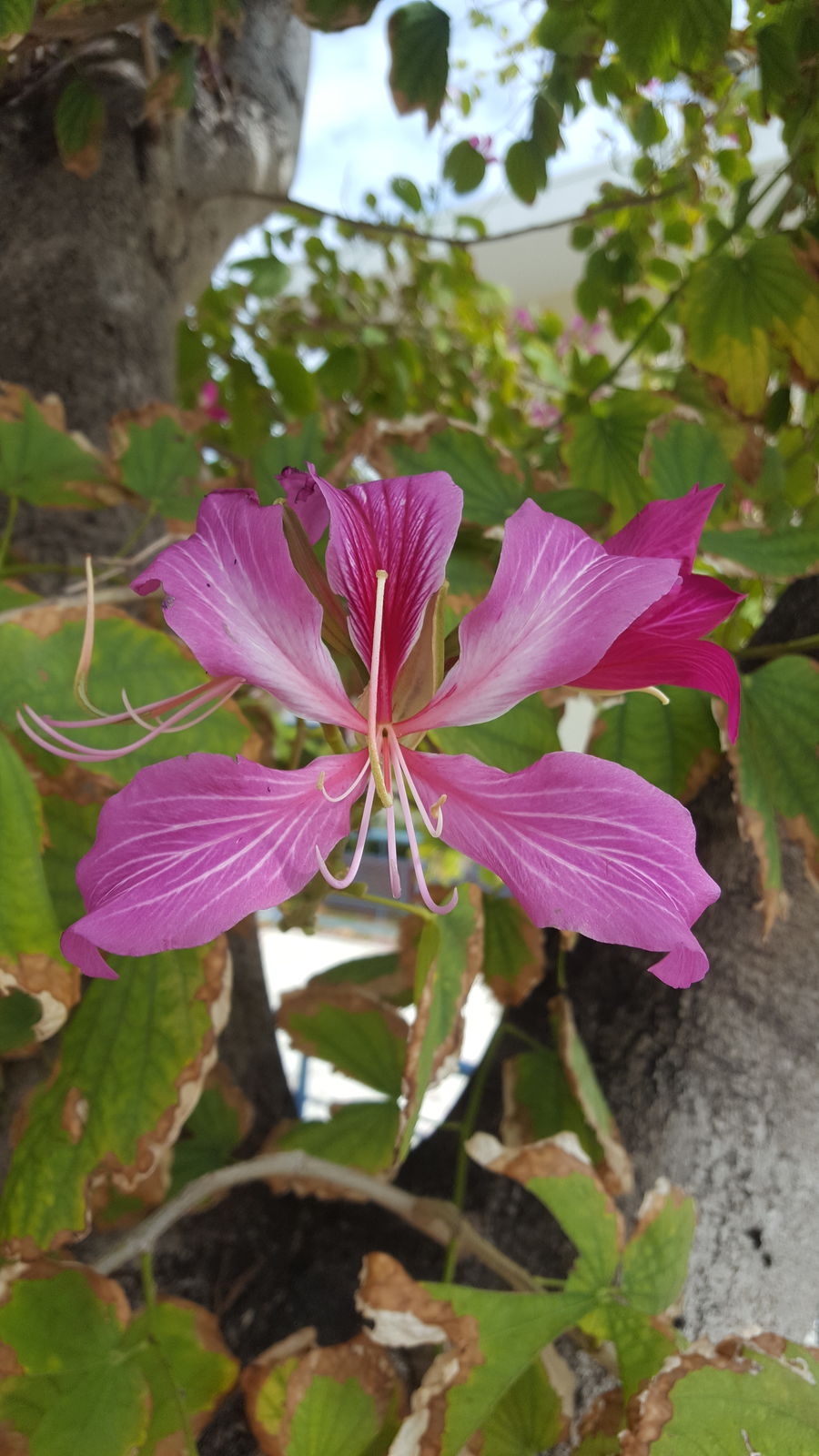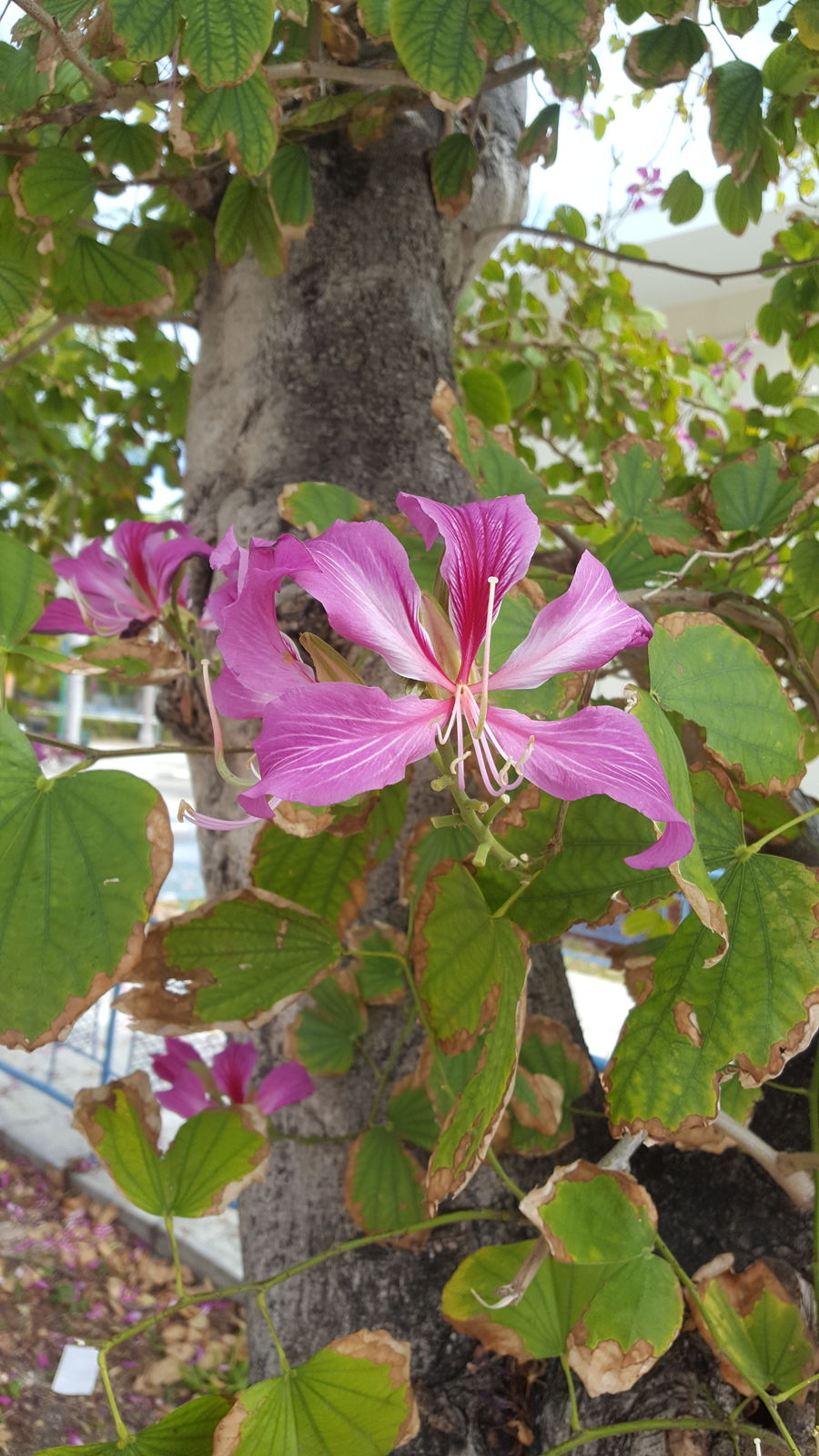Purple Bauhinia
bauhinia purpurea
Also known as: ["Horsefoot Tree","Cowfoot Tree"]
Overview
A deciduous tree known for its striking purple flowers and distinctive leaf shape resembling a cow's hoof.
Benefits & Perks
["long-flowering","wildlife attractant (bees, butterflies, birds)"]
Botanical Classification
| Phylum: | Magnoliophyta |
| Class: | Magnoliopsida |
| Order: | Fabales |
| Family: | Fabaceae |
| Genus: | Bauhinia |
| Botanical Name: | Bauhinia purpurea |
Plant Characteristics
Basic Information
- Category: Trees
- Suitable Location: outdoor garden in warm climates, or large container in cooler regions
- Suitable For:
- Is Weed: No
- Allergenicity: low
Environmental Needs
- Climate: {"temperatureRange":"10–35°C"}
- Hardiness: {"zones":"9–11"}
- Misting: rarely required, only if ambient humidity is very low
- Drainage: Fast-draining to prevent root rot.
- Soil Type: Well-draining, loamy soil with organic matter; cactus or succulent mix can be used for container plants.
Maintenance Level
- Maintenance Level: moderate
- Toughness Level: moderate
- Pruning Frequency: Annually in late winter or early spring before new growth begins.
- Pruning Intensity: Moderate; remove up to one-third of old growth if needed.
Care Details
Ideal Sunlight Coverage:
Full sun to partial shade; 6–8 hours of direct sunlight per day; adjust for intense summer sun.
Sunlight Tolerance Tips:
Acclimate gradually to intense sunlight; protect from harsh afternoon sun; place in a spot with morning sun and afternoon shade if needed.
Care Requirements
Care Difficulty
moderatemoderate
Sunlight
full sun to partial shade
Rotate plant for even growth; use sheer curtains to filter intense light; avoid direct sun during peak hours in summer.
Watering
every 7–10 days during active growth, reduce in winter
Water thoroughly but infrequently; ensure good drainage; adjust based on season and weather.
Soil
well-draining, loamy soil with moderate organic content
pH: Slightly acidic to neutral (pH 6.0–7.0).
Use a mix with good drainage; avoid heavy clay soils; top-dress with compost annually.
Temperature
Thrives in warm conditions; ideal range 65–85°F (18–29°C); tolerates mild frosts but prefers frost-free environments.
Avoid sudden temperature changes; protect from drafts; maintain consistent warmth during active growth.
Fertilizing
every 4–6 weeks during growing season with balanced fertilizer
Apply fertilizer after watering to prevent root burn; switch to low-nitrogen formula for flowering plants; flush soil occasionally to prevent salt buildup.
Propagation
Methods
Stem cuttings or seed; stem cuttings are more common for home growers.
Step-by-Step Propagation Guide
- Take a 4–6 inch cutting.
- Remove lower leaves.
- Apply rooting hormone.
- Plant in medium.
- Keep moist and warm.
Best Time: Spring or early summer when the plant is actively growing.
Environment
Warm, humid environment with indirect light; maintain consistent moisture.
Medium
Well-draining potting mix with perlite or sand; can also use water propagation for cuttings.
Hormone
Rooting hormone is recommended to improve success rates.
Timeline
Roots may develop in 4–8 weeks; new growth may appear in 2–3 months.
Tools Needed
Pruning shears, rooting hormone, small pots, well-draining mix.
Quick Tips
Use healthy, non-flowering stems; keep cuttings out of direct sun; maintain humidity with a plastic bag or dome.
Pruning & Repotting
Pruning Guide
Method
Selective pruning to shape the plant; remove crossing or crowded branches.
Pruning Plan
Prune to maintain shape, encourage bushier growth, and remove dead or diseased branches.
Tools
Pruning shears, loppers, gloves.
Checklist
Sterilize tools; prune during dormancy; remove dead or diseased wood; shape as desired.
Repotting Guide
Best Season
Early spring before active growth starts.
Pot Size
Choose a pot one size larger (2–3 inches wider) than the current one.
Method
Remove plant gently; trim roots if necessary; place in new pot with fresh soil; water thoroughly.
Suggestions
Repot every 2–3 years or when roots fill the pot; beneficial for container-grown plants.
Checklist
Prepare new pot with drainage; trim roots if crowded; use fresh potting mix; water after repotting.
Advanced Care Tips
Watering Mastery
Watering Checklist
Check soil moisture; water deeply; ensure drainage; adjust for season.
How to Apply Water Properly
Water at the base of the plant, ensuring moisture reaches the root zone; allow excess water to drain away; water early in the morning or late in the evening to minimize evaporation.
Watering Schedule Tips
Water deeply once the top inch of soil is dry; reduce frequency in winter to prevent root rot.
Soil Improvement
Add perlite or sand for drainage; incorporate compost for fertility; ensure good aeration.
Temperature Stress Management
Signs of Temperature Issues
Leaf drop, yellowing, or stunted growth in cold; wilting or scorching in excessive heat.
Cold Stress
Slows growth; may cause leaf drop; can lead to root damage in severe cases.
Solution: Protect from frost; move indoors in cold climates; use frost cloth or mulch for insulation.
Hot Stress
Wilting, leaf scorch, or reduced flowering due to excessive heat and dry conditions.
Solution: Provide shade during peak heat; increase watering; use mulch to retain soil moisture.
Fertilizing Guide
Fertilizing Checklist
Check fertilizer type; dilute correctly; apply during growing season; avoid winter feeding.
Fertilizing Method
Use balanced liquid fertilizer diluted to half strength; fertilize every 4–6 weeks during growing season (spring and summer); avoid fertilizing in winter.
Common Problems & Solutions
Toxicity Warning
Cats
Slightly ToxicCats may experience mild gastrointestinal symptoms if they consume Bauhinia purpurea seeds or pods. The plant's toxic compounds can cause irritation to the digestive system, leading to discomfort.
⚠️ Symptoms:
🌿 Toxic Parts:
⚡ Toxic If:
if eaten
Dogs
Slightly ToxicIn dogs, ingestion of Bauhinia purpurea seeds and pods can lead to mild gastrointestinal upset. The plant's lectins and other compounds may irritate the digestive tract, causing discomfort.
⚠️ Symptoms:
🌿 Toxic Parts:
⚡ Toxic If:
if eaten
Humans
Slightly ToxicBauhinia purpurea contains compounds that can cause mild gastrointestinal distress when ingested. The seeds and pods are the primary toxic parts, containing lectins and other bioactive compounds that may disrupt normal digestive processes.
⚠️ Symptoms:
🌿 Toxic Parts:
⚡ Toxic If:
if eaten
Frequently Asked Questions
Q: How tall does Bauhinia purpurea grow?
A: It typically reaches 10-15 meters in height.
Q: Does it require full sun?
A: Yes, it thrives in full sun to partial shade.
Q: Is it suitable for tropical climates?
A: Yes, it is well-suited to tropical and subtropical regions.
Quick Reference
| Family: | Fabaceae |
| Care: | moderate |
| Light: | full sun to partial shade |
| Water: | every 7–10 days during activ |
Get Expert Care Tips
Download the Plantious app for personalized care reminders and plant identification!
Google Play App Store








